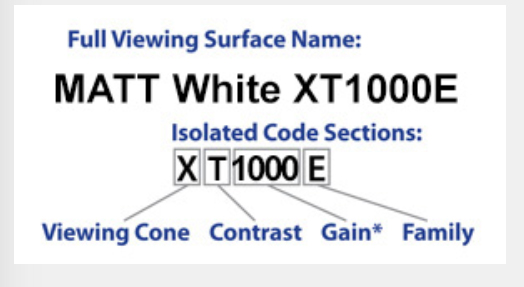
Draper Inc. - May 5th 2017 - Why do projection screen names matter? At Draper, we believe a good name combines clarity with vital information. So, we are introducing some small but important changes to how we name some of our projection viewing surfaces. This small change continues our effort to link screen names to performance, helping you better understand at-a-glance the performance and properties of each screen.
In the past, we referred to projection viewing surfaces using generic descriptive names. While names like Matt White, Glass Beaded, and High Contrast Grey were descriptive, something was missing. The names didn’t tell you anything about performance.
A few years ago, we undertook a massive overhaul of our screen surface naming system. We developed a code-based nomenclature that includes performance specifications in the name. For example, Matt White became Matt White XT1000E. The first letter in the code describes the viewing cone (X=extra wide); the second letter is contrast (T=typical); the numbers are the peak screen gain (1000=1.0); and the final letter is the product family (E=a self-supporting viewing surface that is part of the OptiView family and suitable for Draper non-tensioned screen).
 This change made a lot of sense at the time, but there was still work to do—mostly in our TecVision line. A screen’s performance in ambient light is now one of the most important things to know. In the past, we simply referred to the color of a TecVision surface—i.e. TecVision XH900X Grey or TecVision XT1300X White. But people began taking the word “grey” to mean that those screens were automatically good at rejecting ambient light, and that’s not necessarily true.
This change made a lot of sense at the time, but there was still work to do—mostly in our TecVision line. A screen’s performance in ambient light is now one of the most important things to know. In the past, we simply referred to the color of a TecVision surface—i.e. TecVision XH900X Grey or TecVision XT1300X White. But people began taking the word “grey” to mean that those screens were automatically good at rejecting ambient light, and that’s not necessarily true.
Not all grey screens reject ambient light because they are diffusive and reflective, and don’t reject off-axis ambient light away from the audience. Draper’s TecVision XH700X Grey is an example of this; it’s a grey surface that is designed for image blending, but it doesn’t have ambient light rejecting characteristics.
Because of this, Draper screens that have ALR properties will now include “ALR” in their name. The first such viewing surface to comply with the new system is our latest formulation: CH1200X ALR. In addition, the existing surfaces TecVision XH900X Grey and MS1000X Grey become XH900X ALR and MS1000X ALR. As we add more surfaces to this line in the near future, the ALR suffix will again be used where appropriate.
It’s all part of our effort to make as clear as possible what each surface can do and what it should be used to accomplish.